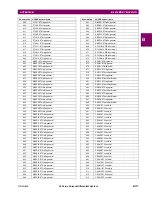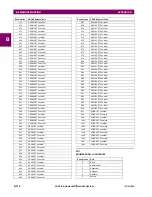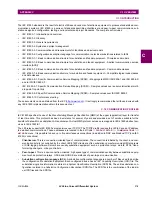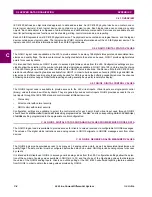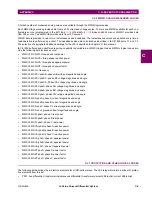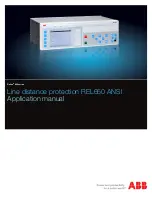
C-10
L90 Line Current Differential System
GE Multilin
C.4 GENERIC SUBSTATION EVENT SERVICES: GSSE AND GOOSE
APPENDIX C
C
C.4.5 ETHERNET MAC ADDRESS FOR GSSE/GOOSE
Ethernet capable devices each contain a unique identifying address called a Media Access Control (MAC) address. This
address cannot be changed and is unique for each Ethernet device produced worldwide. The address is six bytes in length
and is usually represented as six hexadecimal values (for example, 00 A0 F4 01 02 03). It is used in all Ethernet frames as
the ‘source’ address of the frame. Each Ethernet frame also contains a
destination
address. The destination address can
be different for each Ethernet frame depending on the intended destination of the frame.
A special type of destination address called a
multicast
address is used when the Ethernet frame can be received by more
than one device. An Ethernet MAC address is multicast when the least significant bit of the first byte is set (for example, 01
00 00 00 00 00 is a multicast address).
GSSE and GOOSE messages must have multicast destination MAC addresses.
By default, the L90 is configured to use an automated multicast MAC scheme. If the L90 destination MAC address setting
is not a valid multicast address (that is, the least significant bit of the first byte is not set), the address used as the destina-
tion MAC will be the same as the local MAC address, but with the multicast bit set. Thus, if the local MAC address is 00 A0
F4 01 02 03, then the destination MAC address will be 01 A0 F4 01 02 03.
C.4.6 GSSE ID AND GOOSE ID SETTINGS
GSSE messages contain an identifier string used by receiving devices to identify the sender of the message, defined in IEC
61850 part 8-1 as GsID. This is a programmable 65-character string. This string should be chosen to provide a descriptive
name of the originator of the GSSE message.
GOOSE messages contain an identifier string used by receiving devices to identify the sender of the message, defined in
IEC 61850 part 8-1 as GoID. This programmable 65-character string should be a descriptive name of the originator of the
GOOSE message. GOOSE messages also contain two additional character strings used for identification of the message:
DatSet - the name of the associated dataset, and GoCBRef - the reference (name) of the associated GOOSE control block.
These strings are automatically populated and interpreted by the L90; no settings are required.
Summary of Contents for UR Series L90
Page 652: ...A 16 L90 Line Current Differential System GE Multilin A 1 PARAMETER LISTS APPENDIX A A ...
Page 772: ...B 120 L90 Line Current Differential System GE Multilin B 4 MEMORY MAPPING APPENDIX B B ...
Page 802: ...C 30 L90 Line Current Differential System GE Multilin C 7 LOGICAL NODES APPENDIX C C ...
Page 812: ...D 10 L90 Line Current Differential System GE Multilin D 1 IEC 60870 5 104 APPENDIX D D ...
Page 824: ...E 12 L90 Line Current Differential System GE Multilin E 2 DNP POINT LISTS APPENDIX E E ...
Page 834: ...F 10 L90 Line Current Differential System GE Multilin F 3 WARRANTY APPENDIX F F ...
Page 846: ...xii L90 Line Current Differential System GE Multilin INDEX ...


